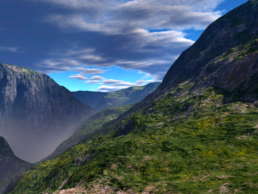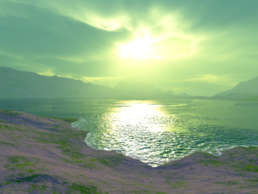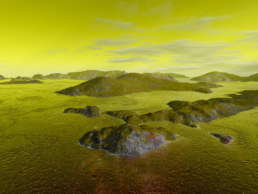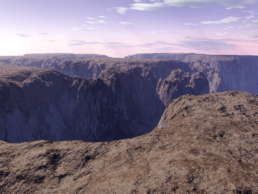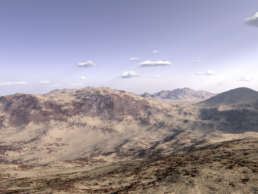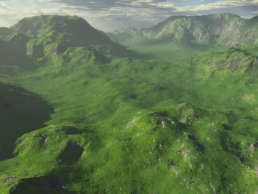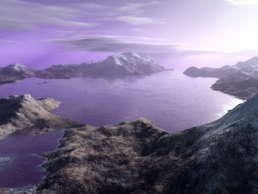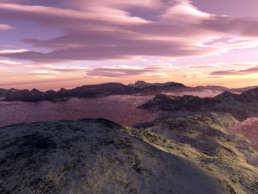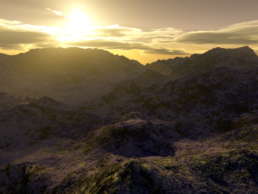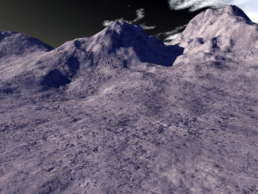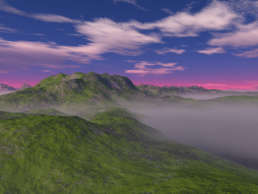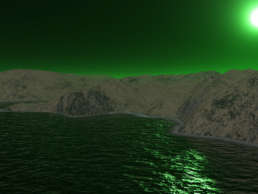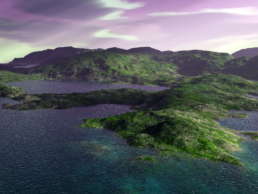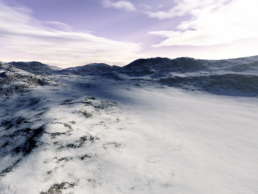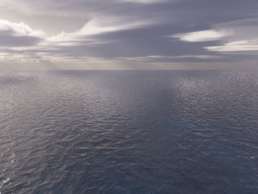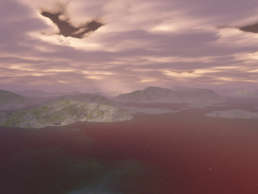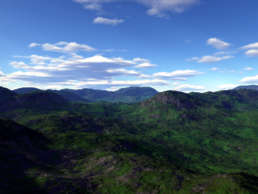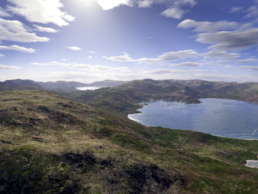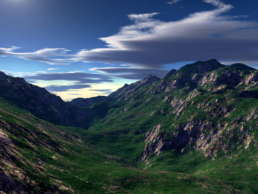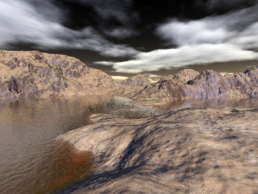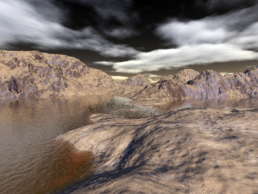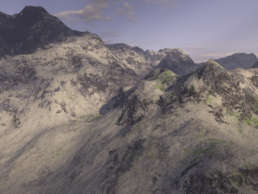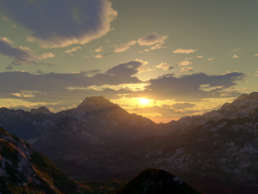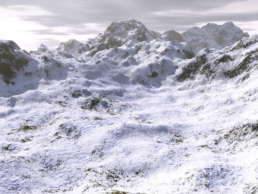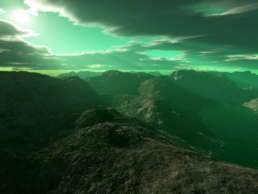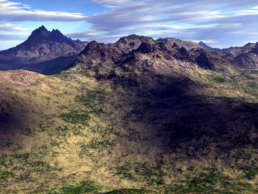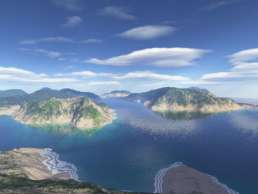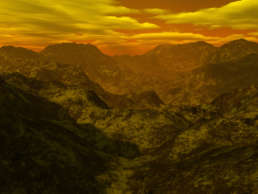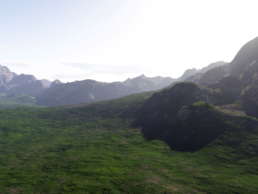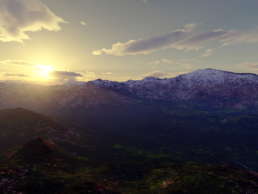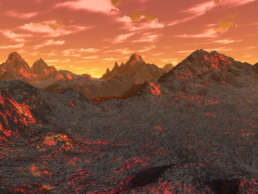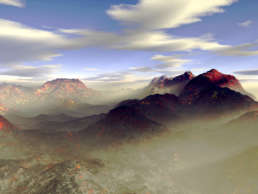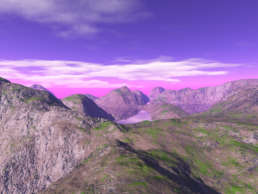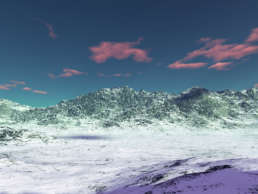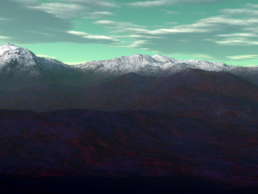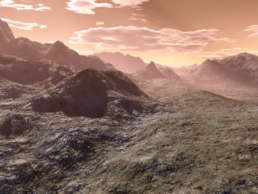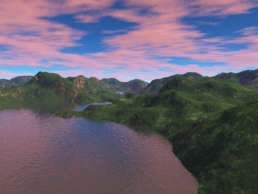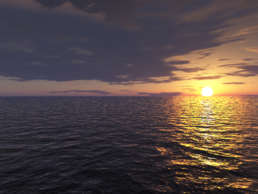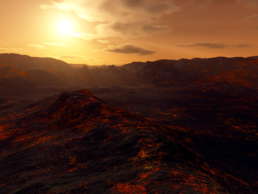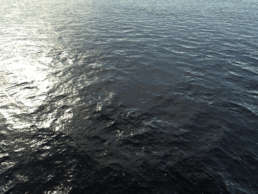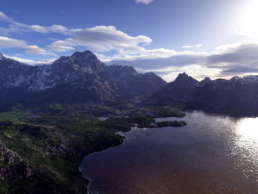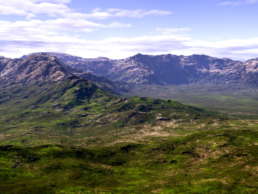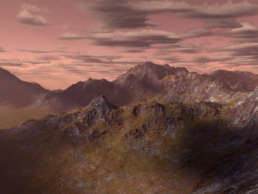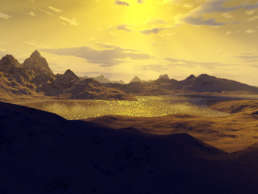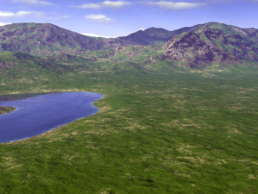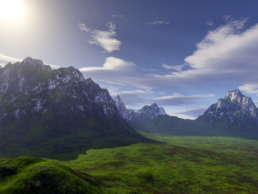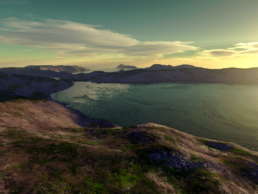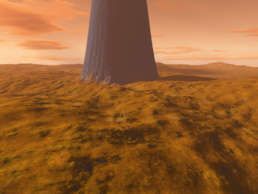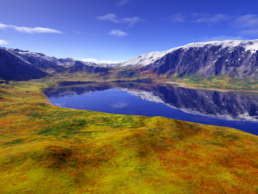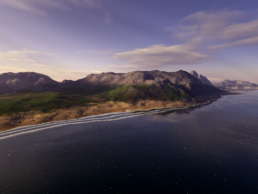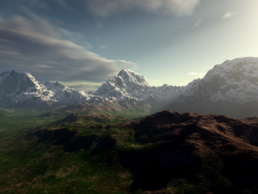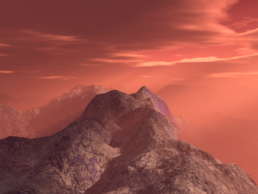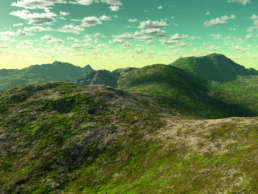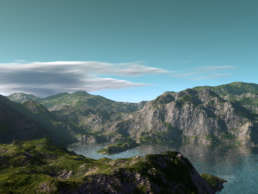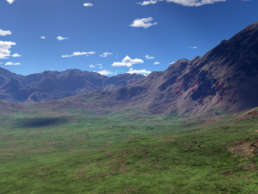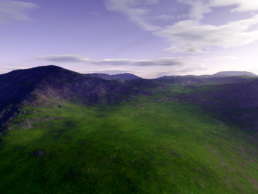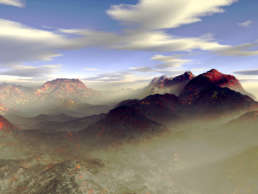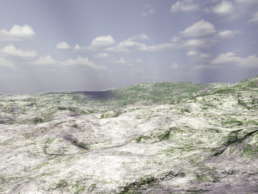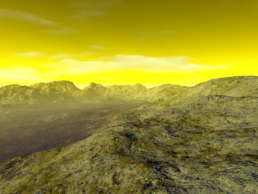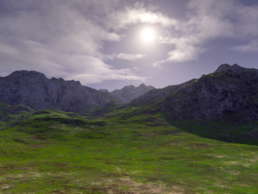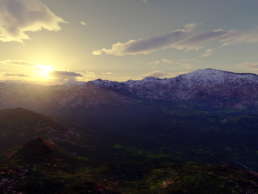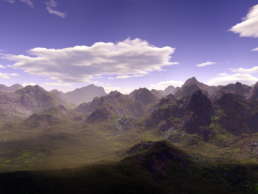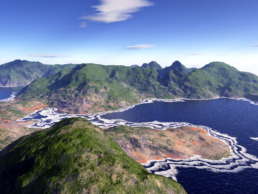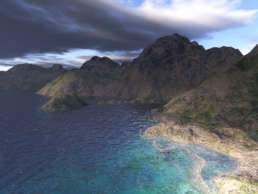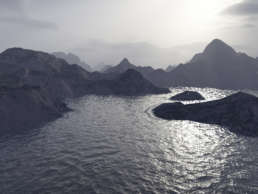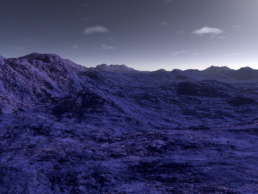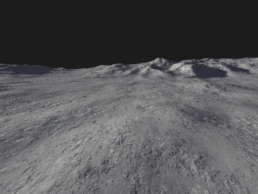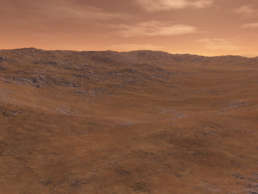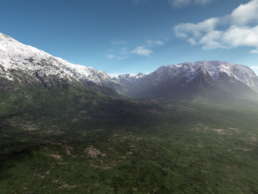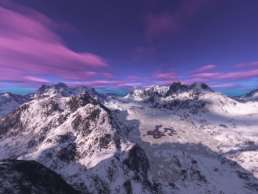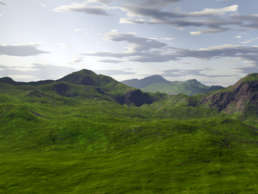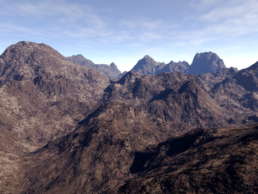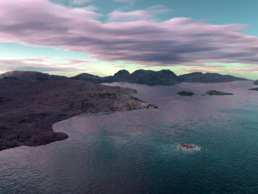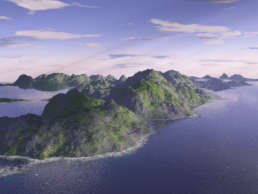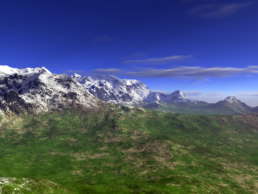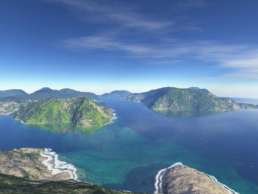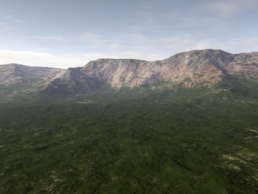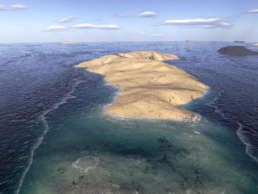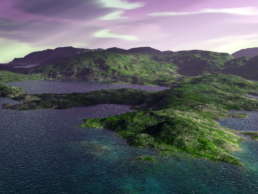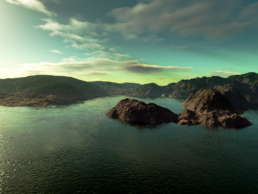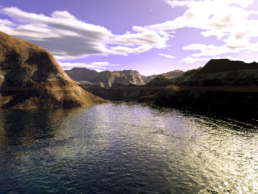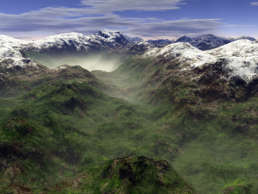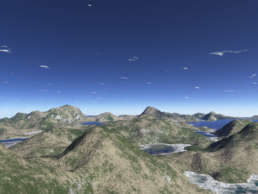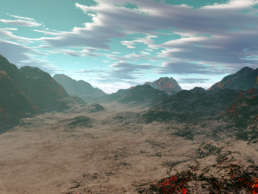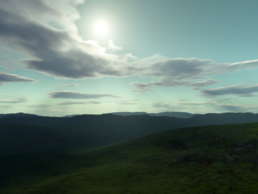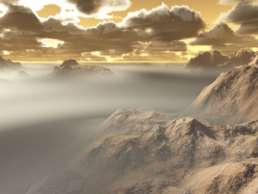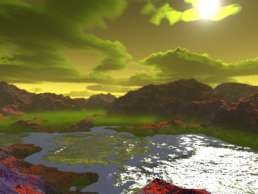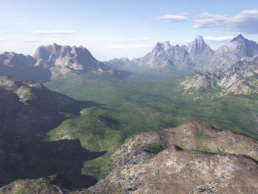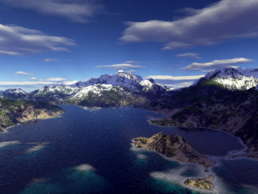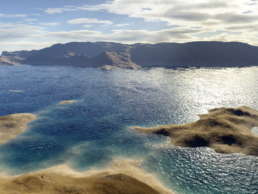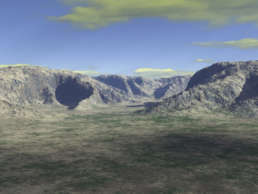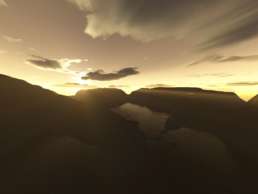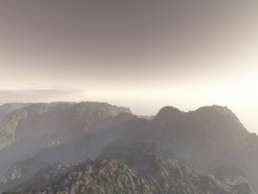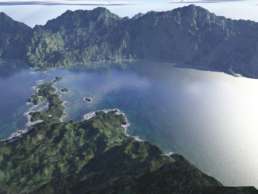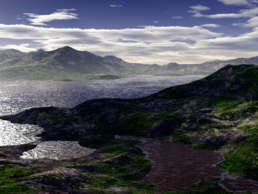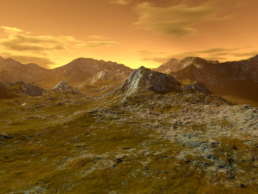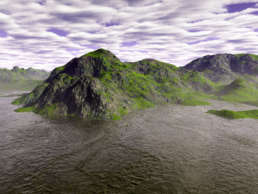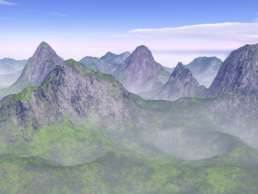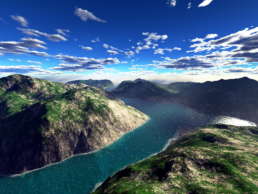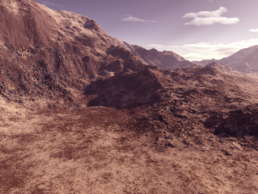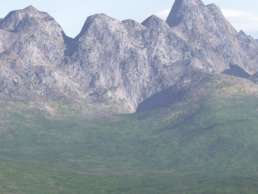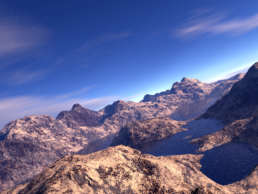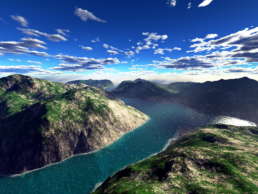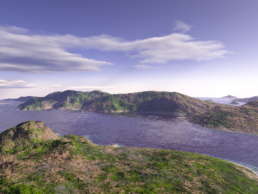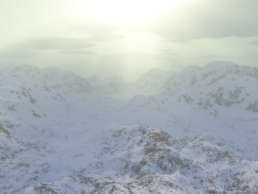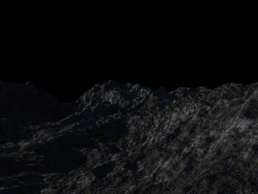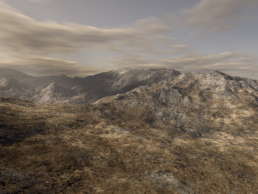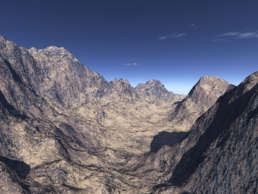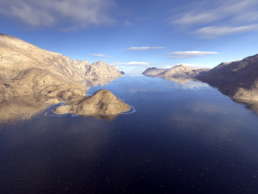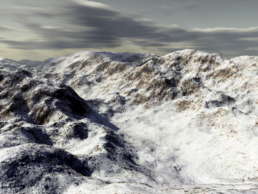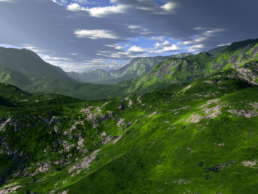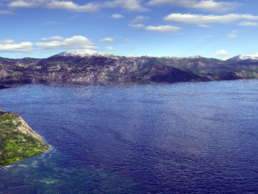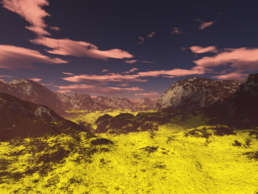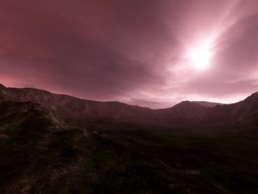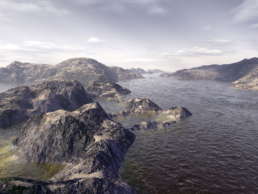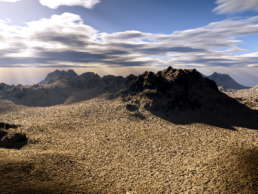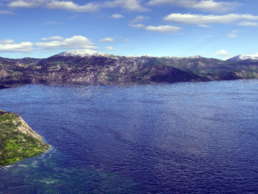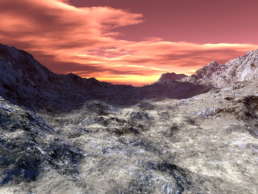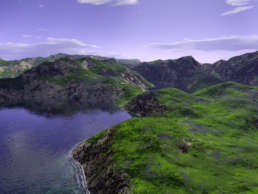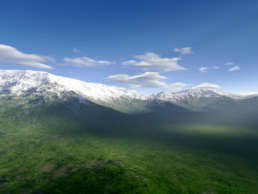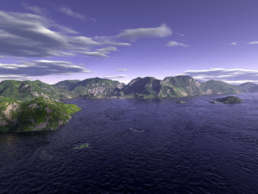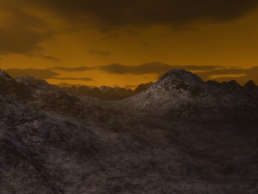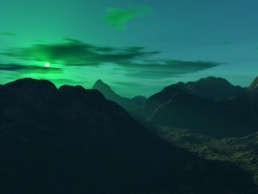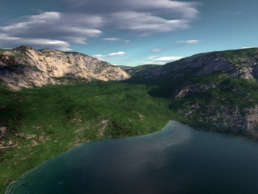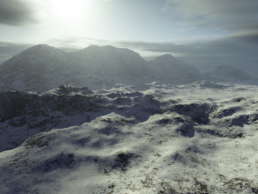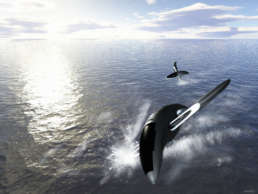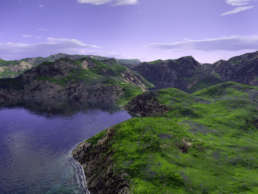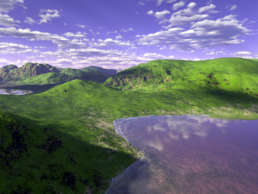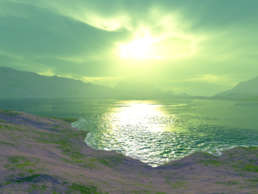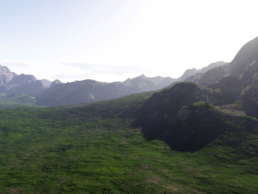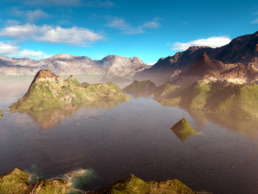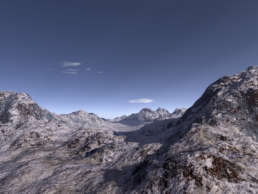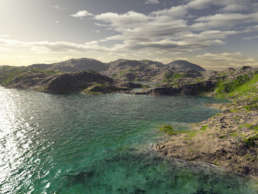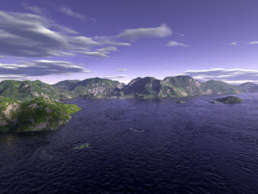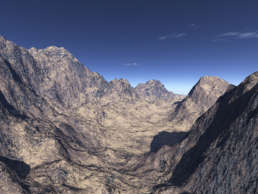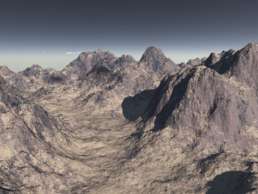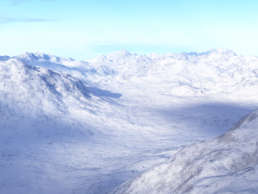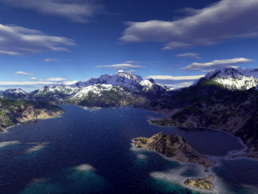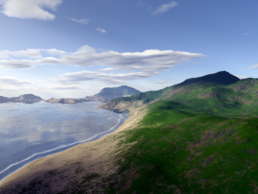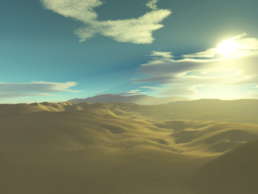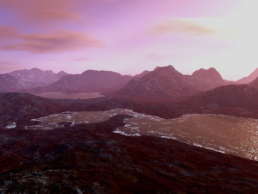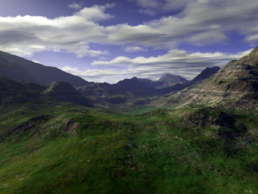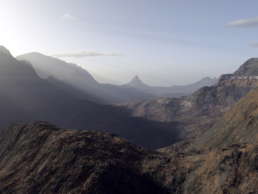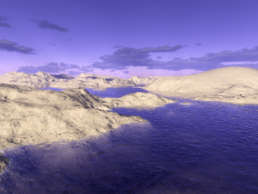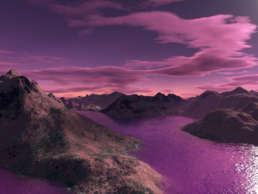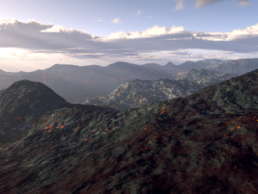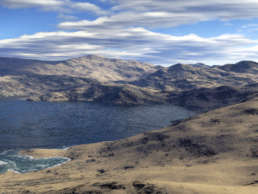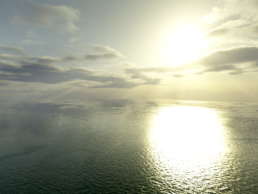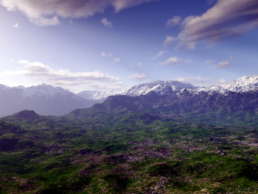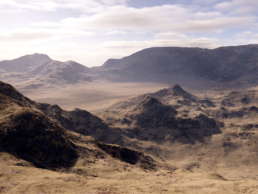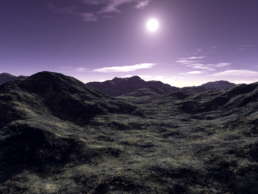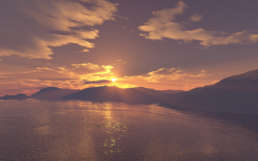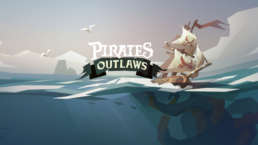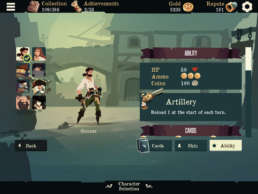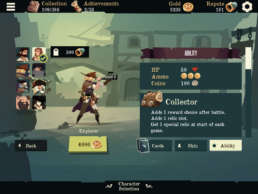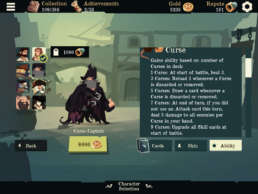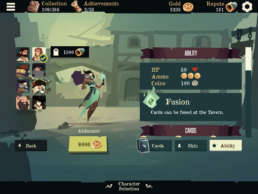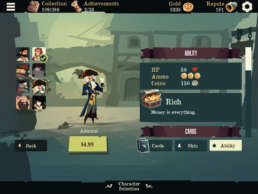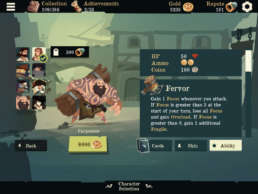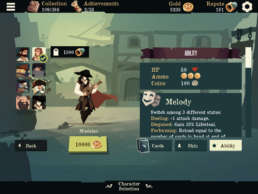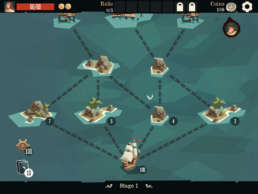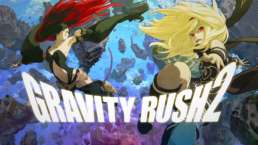Landing Pictures
I found them. Or, what is probably most of them. So, these pictures are the “full rez” 1024×768 versions of the Aftermath landing pictures. One for each world the player could land on. I believe the actual in-game size was somewhat lower and more rectangular, but I’m happy these are the ones I have and not the smaller versions.
Each of these pictures was made in a program called Terragen. The first version. Not the current day version 4 that is used in just about every big name movie you’ve ever heard of. My process started by using the in app tools to randomly generate a height map. Sometimes I was looking for something specific, like a valley with mountains in the background, but most times I’d generate a map, then place the camera in a few different locations until I found one I liked.
From there, Terragen’s tools were fairly simple but fun to play with. It was all about laying different materials one over the other to get a desired look. You’d place limits on each layer to define where it appeared in a scene. Like, if you wanted grass that existed in a valley but not all the way up a mountain you could set a maximum height for your grass layer. You could also set limits based on maximum slope. So, maybe a darker brown dirt would give way to the lighter colored rock beneath it when a hillside or mountain got too vertical. Layers could have sublayers too, so you could have blue specks of flowers only able to appear in grassy areas without having to redefine exactly where the flowers could show up. So, yeah, simple tools but with some mixing and matching you could combine then to make some pretty stuff.
Oh… hover over the pics for the planet names. Most of them have one. 🙂
Aftermath, Just A Few Years Later
What feels like a long, long time ago, I hung out on the message boards of the Mac shareware company Ambrosia Software. I talked with like minded kids about things like games and movies and tech. The Ambrosia forums must have been my first real push out into the world of internet friends.
Along the way I did my first coding/hacking/game design by making levels and missions and even an interesting Star Trek themed total conversion for the hybrid space action / real time strategy game Ares.
Later, as I got sucked into the world of the space action RPG Escape Velocity: Override, I began my earliest fray into writing and fan fiction. You can still find my series of short stories of Captain Ragashingo and the crew of the heavily armed cargo transport the Indigo Star over at fanfiction.net. I still write to this day because of those early stories I shared with others on the Ambrosia boards.
A few years later, the third game in the Escape Velocity series, Escape Velocity: Nova, came out and a year or two after that, this secretive group of mission editors, 3d graphics experts, and storyline writers in our little Ambrosia community started posting the smallest teases of something they called Aftermath. It’s wasn’t quite a Total Conversion where the ships and planets and universe were replaced by a different one. Instead, it was a surprisingly high quality continuation of the 3rd game’s universe set some decades later. It was one of the most anticipated EV:N project going, but very few people knew anything about it.
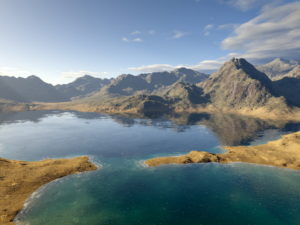 Around that time I had gotten into making landscapes with a free program called Terragen. It had a Mac version and I got somewhat decent at it. Even won a weekly challenge over at the company’s web boards for best landscape created without all the fancy add-ons the PC version supported! Then, one day, out of the blue, someone from this hush hush Aftermath team approached me. They’d seen my work on the Ambrosia boards (we had a Just Graphics sub forum where some in our community posted cool art they made) and they invited me to join.
Around that time I had gotten into making landscapes with a free program called Terragen. It had a Mac version and I got somewhat decent at it. Even won a weekly challenge over at the company’s web boards for best landscape created without all the fancy add-ons the PC version supported! Then, one day, out of the blue, someone from this hush hush Aftermath team approached me. They’d seen my work on the Ambrosia boards (we had a Just Graphics sub forum where some in our community posted cool art they made) and they invited me to join.
Aftermath was even cooler than it seemed. We had so many ship and planet graphics that we were pushing the limits of what the Escape Velocity engine could handle. We had so much story and so many complex missions planned that we were far and away past the limits the engine could support. We got the engine changed and updated to support some of the stuff we wanted to do, but our project was still so big that we figured we’d need to split the experience up into several different parts based on which storyline and faction a player wanted to play. You’d drop in the Pirate storyline, or the Neo Federation, or Sigma Shipyards storyline and be locked into those missions along with a core set of the typical trading missions that would be common to all the storylines.
My poor 400Mhz Indigo iMac DV and later iBook G4 spent night after night rendering for upwards of 24 hours for each individual landing picture. I completed hundreds of them, one for each planet you could land on. I also convinced the other Aftermath team members that I could be a story / mission writer, too. I had a neat plot line called Detective Story in mind where the player could become something of a upstanding bounty hunter and could, with a bunch of tricky behind the scenes scripting, build their own fleet of allies that they could send on missions to help them hunt targets. You can do a lot of neat stuff by causing missions to auto complete with a percent chance to complete successfully or unsuccessfully! It would have featured a lot of writing, a strong plot, and, my favorite part, you could also play the same story from the point of view of the bad guys. And you’d essentially fight the other you from the other version of the storyline. You’d have to play the storyline twice, once from each point of view, to truly understand everything!
The Aftermath team was spread out across the US with at least a couple of us even further away. We chatted on IRC and AOL Instant Messenger and on our own private boards. We encouraged each other and nagged each other and sometimes had little arguments about the direction of the project. We even once got social engineered into accidentally letting someone into our hidden forums where they stole some of our in-progress work and tried to show it to the Escape Velocity community! Fortunately we had some friends in high(er) places who helped shut that down.
Eventually, the Aftermath project died out. Honestly, most of us were just high school students making our way toward college. Lots of other things became more important. That, and the scope of the project was legitimately quite large, at least as large as any of the Escape Velocity games that sold for $20 or $30 back in the day, and few of us had any real experience managing something that big.
Still, we produced a bunch of cool stuff that never really saw the light of day, and we hand some grand plans to produce even more. A couple of the other team members have revisited their memories of Aftermath in the past few weeks, so I thought it would be fun to join in. Check out my gallery of landing pictures I made for the project, here.
I also have some of the world building short stories and some of the early missions of Detective Story. I’d love to share those and some of the larger concepts of what I was wanting to do with my slice of Aftermath’s very ambitious narrative and gameplay goals.
Aftermath may have fizzled, but it was a fun time, and if just a few more things had gone right or even if the internet was a more common medium like it is today, we might have all been paid game developers back then! We certainly generated a lot of interest and respect from our peers in our community. So, here’s to Aftermath, by far the biggest and most ambitious of the EVN community led projects!
Review: Pirates Outlaws
This morning, I ran aground on a fun new game for my iPhone and iPad called Pirates Outlaws. I’ve always had a soft spot for turn-based games, and always wanted a good card-deck-baed game that I didn’t have to struggle too much with collecting the cards or battling real people with way more time on their hands. Pirate Outlaws has fulfilled both of these wants for me. The game bills itself as a turn-based, card deck building, roguelike. That last part is important, because instead of being something like Hearthstone where you need to build up your decks and strategies over long periods of time, in Pirates Outlaws, you deck resets at the end of each adventure you take.
On a basic level, Pirates Outlaws is a fun turn-based game where you battle AI controlled pirates across islands and beaches. Your single character is on the left, while up to three enemy pirates fill the right side of your screen. At the bottom you have five randomly chosen cards in your hand. Some cards attack and do damage to the enemy. Some apply defenses like armor or dodging to your character. And a wide variety apply buffs or debuffs to yourself or your enemies. Some cards are free to use, while others cost ammo that you generally get by playing an ammo card. It’s up to you to strategize on the fly from one round to the next in order to get through the battle.
At the end of very battle, you gain some Gold, and are given three new cards to add to your deck. Over the course of a single adventure you’ll go through several battles and, if luck is on your side, you’ll be able to tailor your deck to match your chosen character’s skill set.
Characters? As in more than one option? Yes! Although you start off as the Gunner class who generates one unit of Ammo per round, it doesn’t take long to unlock the second character, a Sword Master who converts 25% of the damage she deals to health for herself when her hp is below 50%. The six other characters will take longer to unlock, but each of them has their own unique skills that feel like they have a lot of promise.
In terms of gameplay, Pirates Outlaws has a similar loop to FTL: Faster Than Light. You start at a sea map of battles, taverns, and markets and have to pick and choose your way towards the top of the map where a random final boss waits. Your ship only has so much endurance so you need to pick your routes wisely. You can buy more health or a range of new items at the taverns and markets. A full game usually lasts from ten to twenty minutes, and when you are finally killed you receive a last round of Gold and Repute based on how far you progressed.
Overall, I’ve found Pirates Outlaws to be that perfect mix of turn-based decision making, card building strategizing, and roguelike freedom to screw up knowing that you’ll be free to give it another go next time around. The game cost $.99 on Apple’s App Store and is also available on Android. It has a variety of In-App Purchases to speed your way toward unlocking new characters. It looks like there’s also new world maps you can buy as well, but so far I’ve found the game to be very enjoyable with just the two early characters and the one randomly generated map.
One key for me is that the game runs without an internet connection. You can’t buy more Gold through in-app purchases when not online, of course, but other than that, it will happily play anywhere at any time.
So, if you’re looking for a fun, easy to play turn-based game that has a surprising amount of depth, you should check out Pirates Outlaws.
Review: Gravity Rush 2
I recently started playing Gravity Rush 2, and… I’m loving it!
For me, this was a game I saw a trailer or review for sometime early last year but quickly wrote off as yet another “I guess I’ll never play that because I don’t own a PS4.” Between now and then I got a PS4, and a few days ago I remembered this game. Small warning, I will be mostly avoiding main storyline spoilers but I’m gonna talk a lot about the game including some of the initial plot setup and some of the activities you do. Those looking to be spoiler free may want to check out now.
Gravity Rush 2 is a continuation of the adventures of Kat, a teenage-ish girl who for some reason has the power to alter gravity in her vicinity. This power comes from her pet cat named Dusty whose coat looks almost exactly like the weird, distorted black star field effect used for the Darkness in Destiny. If Dusty is not nearby or is trapped or incapacitated, then Kat loses her gravity powers.
So, what does Kat do with gravity powers? First and foremost, she uses them to fall through the skies! In game terms, you press R2 once to activate Kat’s powers which leaves her floating stationary above the ground, then you point the camera/cursor where you want to fall towards and hit the button again.
The game, and even Kat herself, has no illusion that she flies anywhere. She falls to where she is going and her animations show that. While you can do some things to have Kat strike a more traditional superhero flying pose, holding X to fall faster usually works, for the most part she is fine with twisting and tumbling about as she falls in whichever direction she chooses. It’s an unexpected delightful way to transverse an open world.
Kat’s other core gravity based power is picking up various objects in a “stasis field” and effortlessly holding them in midair as they float and tumble near her. She does this for people and objects to take them safely to other destinations, and she also can pick up and launch debris in combat to damage enemies. (And sometime the people she picks up and throws are her enemies!)
Kat also has the ability to “gravity slide” which sorta tilts gravity at an angle and lets her slide down any surface as if she was always sliding down a very steep incline. It can be useful for traveling along a curving surface since she is constantly adjusting which direction “down” is. She could slide along the inside of a Sonic the Hedgehog loop, for instance, by using the power. I don’t use this one much because there was very rarely a reason to and because it makes moving around more tricky than it should be. Your ability to aim yourself is very finicky.
Kat’s final core gravity ability, which I do like a good bit, is that if you fall into the side or even the bottom of a flat structure, Kat will instinctively flip gravity around so she can run and jump across it as if she were standing right side up. This means you can stand on the side or even on the bottom of buildings. This also works on other objects like the sky flying cars and ships buzzing about the sky. It’s a little mind boggling to move around the bottom of a building as if you were right side up, but it’s also pretty awesome and the game handles this kind of thing perfectly. Like, your ability to clamber up a wall Destiny 2 style works just as well on the bottom or side of a structure as it does when you are right side up. (I like game engines that just seem to do the right thing effortlessly vs engines where something seemingly works sometimes and not other.)
The open world of Gravity Rush 2 can be summed up in one word: “Super Great” … Ok… that was two words. Let me try that again. The open world is: “Very well done” …. Well darn. One more try? No? Fine. The point is, I like it a lot. The game starts with Kat indentured to a small flying trading town that took her in after she was sucked from her home dimension via a gravity storm. This little town made of a dozen or so small buildings flying far above the clouds is a nice training area, especially since the game starts you out without your gravity shifting powers. So you learn to navigate around the town on foot before you regain your pet cat (and thus your gravity powers) within the first 30 minutes of gameplay.
From that point what was a sorta difficult area to navigate around (since most of the buildings of the town are not connected to each other forcing you to always take the long way around bridges and catwalks) becomes dead simple to make your way around as you just fall to where ever you want to go to. The game and initial story setup/training really does a nice job of showing you just how useful your gravity powers are by forcing you to move around without them at first.
Not long after that, the mining town finishes its work and returns to its port city to resupply. It’s here where the game really begins. The flying city of Jirga Para Lhao is big, beautiful, and complex. At first glance, it appears to be made up of multiple small-ish floating islands, and to the game’s credit most of these islands seem to have an in-world purpose. The island your little mining town docks at has a market right off the docks but also has a small residential area and a few taller buildings. In the distance are other islands, some sporting skyscrapers, some are clearly shipping docks or warehouses.
Though this is a game you usually spend above the ground, landing and walking around is a joy because of all the little things going on in the city islands. There’s people shopping, people running the shops, people moving crates around, people juggling, people sitting on benches, groups of friends having conversations. There’s even kids and birds and dogs and cats and ducks.
This is not a game like Arkham City / Knight where everyone goes away leaving the play space devoid of almost all life. Instead, each island feels alive and more than sufficiently detailed. Plus the architecture is nicely detailed and varied. There’s bridges and water towers and lighthouses and all sorts of cool things all over the place. In some ways it feels like a somewhat more modern version of Bioshock Infinite’s floating city of Colombia… remade as an open world… without the racism.
For the first hour or so you have a blast exploring this open world, but then, at some point, you remember that you can fall wherever you want so you decide to test the limits and fall as far up or down as you can. When you do that you quickly find that the set of islands you can see around you are just part of the flying city you are in. High above the main city is a series of flying estates sporting mansions, parks, and gardens. Rich people and high class pets dot these more sparsely populated areas. And far above them is an official looking government building. And above that is a fortified flying military base complete with anti-air cannons that force you to keep your distance.
Go down, and for the first few seconds you think you’re just gonna descend into an endless layer of clouds, but then you sorta break through and find that there’s an entire flying shanty town populated by the poor and downtrodden. This group of twenty or more mini islands is definitely far more rundown than even the “normal” mid level islands and is in complete contrast with the flying estates far, far above.
All in all, the playable space in Gravity Rush 2 is just delightfully large and it surprises you at being even bigger than you thought it was when you first step foot off the flying boat dock. Oh… then in the mid to late game the map size and complexity doubles!
I don’t really have much to say about the graphics and animation of the game, other than they are fantastic. Kat’s character animations are especially superb. The way she tumbles if you land too hard or the way she strings snappy kicks together during combat are a joy to watch again and again. And, the use of fog to partially obscure distant parts of the city works really well. Up close everything is colorful and vibrant and just all around well done while the fog helps enhance the feeling of being in a huge play space. Oh, and the dogs are super cute, too!
So, what is there to do in this delightful open world? All this space would be wasted if there was nothing to do. There’s two main parts to Gravity Rush 2: The main story, and a bushel of side quests.
The main story is pretty long and is split into at least three main segments. A lot of it is told through a fairly unique series of comic book style panels. You’ll start at one panel then press X and a character will maybe move in from off panel or someone who was in the panel will get a speech bubble usually accompanied by a word or short phrase of spoken dialogue to give a touch of tone and mood to what you read in the speech ballon. Then you press X again and maybe another character replies or another speech bubble appears. Each panel gets two or three little events like that then you shift left or right or up or down to the next panel, as if reading an animated comic book.
A typical “cutscene” is usually around 5 to 10 panels long and the art is great. It fits very closely to the game’s graphics and does not feel out of place at all. One thing this game doesn’t have is fully voiced dialogue. Often the characters will speak a few words along with their speech bubbles that you read. What little speech there is sounds like a strange half French half Japanese and is more for tone than anything else. The voiced phrases almost never have enough words to match what was actually said in the speech bubbles. Still, it works well enough and was never really a negative or a distraction.
I liked the main story. Some pretty big things eventually happen, but Kat does her best to maintain a cheery, upbeat attitude. My only complaint is that it sorta forgets that I didn’t play Gravity Rush 1 and a few characters I didn’t know pop up to help or hinder Kat in rapid succession without much introduction.
Maybe the real draw of Gravity Rush 2 isn’t the main story but is instead the side quests. These too have fun, comic book style cutscenes, and cover a surprisingly wide variety of tasks. Of the top of my head, over the course of the game Kat has:
- Gone mining for minerals in a ruined city
- Helped deliver a last crate of cargo to a departing airship that forgot it on the dock
- Delivered a ton of newspapers all across one of the larger islands
- Tracked down a shop and its owner based on a photo where you had to pay attention to the direction and distance of objects in the background
- Run annoying errands for the wealthy high class jerks on their private floating islands
- Watered some trees (one of Kat’s powers is picking up nearby objects and if she does it near a source of water she will hover globs of water around herself until she throws them)
- Starred in an action movie
- Impersonated a local hero in order to trick people into buying ice cream
- Tailed a cheating boyfriend through the entertainment district
- Flew a little girl around a park to keep her entertained
- Helped a journalist uncover corruption by taking a photo of a government guy and a criminal during a secret business deal
- Survived police training
- Helped a daughter buy a present for someone
- Looked for a new place to live
- Raced a bird to prove who is ruler of the skies
- Broke up a student lead demonic cult
- And… I don’t know… a whole bunch of other stuff
While a couple of these missions do repeat their basic gameplay elements, no two is exactly alike and even the ones that are similar still have you doing those similar things for very different reasons and at the behest of entirely different characters. And, as you can see from the list above, most of the things you do are just delightful!
But maybe the best part is Kat who, while not one note by any means, is pretty consistently upbeat about things. She very often jumps at the chance to help people and even when things don’t go her way she still usually find a bright spot to hold on to. Her charming, adorkable personality is a nice, refreshing change to most modern open world heroes and heroines (such as Aloy or Geralt or… uh Batman who all tend to be more cynical and grim about everything.)
So, there’s a ton of side quests, many of which involve fetching or finding things. But there’s also a fair amount of combat. Certainly the main story gets very combat heavy by the end, and some of the side quests have a fair amount of combat as well.
On the ground, Kat can chain together a few rapid kicks and you have a dodge function that has you tumble out of the way. It’s not exactly Arkham style where you try and keep a flow going, but it doesn’t feel bad. In the air, though, is where you’ll be doing a lot of your combat. And there you have a variety of options from lock-on kicks that track enemies, to picking up and throwing things around you, to charged power attacks, to special attacks like slamming through a bunch of enemies or hovering in place as you constantly bombard enemies with debris.
The combat is just a little clunky because of the 3d any direction goes aspect of the game, but it still works pretty well. A lot of it is anticipating the direction you need to swing the camera around to keep attacking enemies. You have pretty good control of your own movement and you are generally in big open environments so combat is fairly fun. Occasionally, though, you are forced to fight in enclosed spaces. And there things become a lot more annoying. Not a huge turnoff or anything, but fighting in enclosed spaces as a character than can quickly fall in any direction… doesn’t work nearly as well as when she has room to move.
One thing I did enjoy was the boss fights. I’ve battled everything from giant walker robots that would be right at home in Sonic Adventure, to a boss I had to destroy parts of before I could attack its actual weak spots, to one boss that was perhaps the biggest enemy I’ve ever fought in any game, to at least a couple of bosses that were comparable to Kat in size, speed, and power.
All in all, Gravity Rush 2 is a delightful game, with an adorkable main character, a detailed, charming world, a ton of interesting side quest, and a main story that covers a lot of ground and eventually ups the stakes to epic levels.
My biggest likes were Kat’s personality and movement powers. Falling through the skies as an upbeat character just works so well.
My biggest dislike was the way the late story threw in a few characters that I had never seen before. Some of them Kat had clearly met before but they needed more introduction, for sure! Also, Kat’s solution to the final boss pretty much came out of nowhere and wasn’t even really shown on screen. 🙁
If you haven’t played Gravity Rush 2, I highly recommend it. I got it for pretty cheap off the PlayStation store and I bet an actually diligent deal hunter could find it for even cheaper than I did.
Review: Hellblade: Senua's Sacrifice
”Hellblade Selling Above Expecations, Nearly Breaking Even For Developer” is a bit of a downer title for something that is far more exciting. The news isn’t that Hellblade is going to turn a profit, quotes from the studio make it clear that was always going to happen. It’s that Hellblade is going to turn a profit months earlier than expected, meaning the game is selling rather well.
”We own the IP this time. It’s opened up a bunch of doors and possibilities that we just didn’t have until this point.” Antoniades, chief creative director at Ninja Theory told GamesBeat. “In terms of a model, I’d say it is a success.”
Not only does Ninja Theory own the IP to Hellblade, they self published it. In doing so, they necessarily made a smaller game with a smaller team than a AAA title gets, but now they are reaping that reward as there is no EA or Activision there to take their share of the profits.
The exciting thing here is that maybe, just maybe, this could be a signal to the industry. Not every game needs to be a massive AAA adventure. Not every game needs to be filled with random loot boxes. Making a good game on a less astronomical budget can work!
And yeah, Hellblade: Senua’s Sacrifice is a good game. I played it over the course of two days and thoroughly enjoyed it. Without jumping straight into spoilers, the game opens with Senua, a Celtic warrior on a quest into a Norse version of hell to save the soul of her lover after he is tortured and killed in a Viking raid. Except, this isn’t a game about a heroic damsel or femme fatale epically storming the gates of hell. It’s a story about a deeply troubled young woman being pushed over the edge by tragic events trying to overcome her own demons while giving everything she has to save someone who she loves.
It is a very dark, very gritty game. Starting at about a minute in, things like bodies impaled on spikes is a normal you’ll need to accept. The game includes somewhat graphic looks at things like fire sacrifices, making your way through a dark place filled with monsters, or what it feels like to die. But all of this is in service to its story and is laser focused on what Senua is feeling and experiencing. Ninja Theroy worked long and hard to correctly portray various aspects of mental disorders in how Senua reacts or sees the world. This is a game where what they called “the low hanging fruit” of correctly portraying psychosis meant making amazing and chilling use of 3d positioned voices constantly talking to you, laughing at you, encouraging you, mocking you, and being afraid for you and for themselves!
All in all, the story is dark and introspective and extremely well done. It’s told fairly out of order, but I like that sort of thing. Piecing together what happened and when and why without everything being spoon fed was a fun challenge. And the acting done for Senua is the best I’ve ever seen in a game. Period.
Gameplay wise, Hellblade: Senua’s Sacrifice is something like Epic’s Infinity Blade mobile games from a few years back. Senua is the best rendered character model I’ve seen in a game, but they can get away with that because the entire game is a close up perspective on her which limits the amount of environment that need to be rendered. It all looks really good, but there is that sense that it can only look so good because it is very carefully keeping you to tight hallways on outdoor corridors of trees or whatever.
The combat also reminds me a good bit of Infinity Blade. Combat has a very fixed feeling to it in contrast to something like Tomb Raider or Horizon: Zero Dawn. Instead of scampering and dodging in an open world, combat is always in small-ish circular areas or occasionally on wide bridges. Instead of the camera being freeform, it is always behind Senua and always focused on an approaching enemy. At first, it can feel a little restricting. You can switch which enemy the camera focuses on (and thus which enemy you are engaging) but you are basically always facing an enemy.
Fortunately, this somewhat fixed, somewhat mechanical feel is made up for by simple but very well done combat. Combat is a game of dodging, blocking, attacking, and counter attacking. If the sort of base sword wielding enemy is about to try and hit you with a heavy attack you can see it in his great character animation and choose to dodge to the left or right, or you can hold a block and absorb the impact while being thrown off balance, or you can counter with a well timed parry that will allow you to flow into a counterattack combo. So, combat is about picking the correct move in real time to avoid damage or attack your opponent. Enemies with light swords can be beaten through easy blocks and the occasional heavy attack to break their guard. Enemies who carry a shield require a kick or a shove to break their guard since your direct frontal sword attacks are mostly useless. There’s also slow enemies with large heavy swords, and fast enemies who duel wield knives that they can throw at you.
Combat gets frantic and challenging as the game throws more enemies at you. They cluster around you and it becomes a game of picking the right enemy to focus on and of dodging and blocking enemies who attack from the side or behind. And all of this is happening while a chorus of voices in Senua’s head cheer you on, or warn you of an attack behind you, or fret as you take a hit, or taunt you as you are about to die, or urge you to finish an injured opponent. Once again, this game is gritty and violent. Get knocked down in combat and you can see the pain on Senua’s face. Having to stand back up after a near fatal blow feels hard and the game even goes so far to drastically limit your attack speed and power for a few seconds until you recover. It makes every battle tense and terrifying, even if mechanically there isn’t really as much danger of failure you are lead to believe. There are certainly times where you chain together dodges and attacks and blocks and combos that let you slice through an otherwise hard group of enemies and it feels very satisfying… so it’s not all grit and pain. It is fun, as well!
Taken all together, from the extremely excellent facial capture and acting for Senua, to the hellish story about her quest to defy the Norse gods, to the combat that is somewhat simple but deeply satisfying, to the various set pieces and puzzles you’ll face, Hellblade: Senua’s Sacrifice is a fantastic game. It is not particularly long. Maybe 5 hours. 10 hours at most. But those hours are packed with narration and combat and storytelling and creepy frightening sights.
That the game is apparently doing well and is being considered a success pleases me greatly! 🙂

